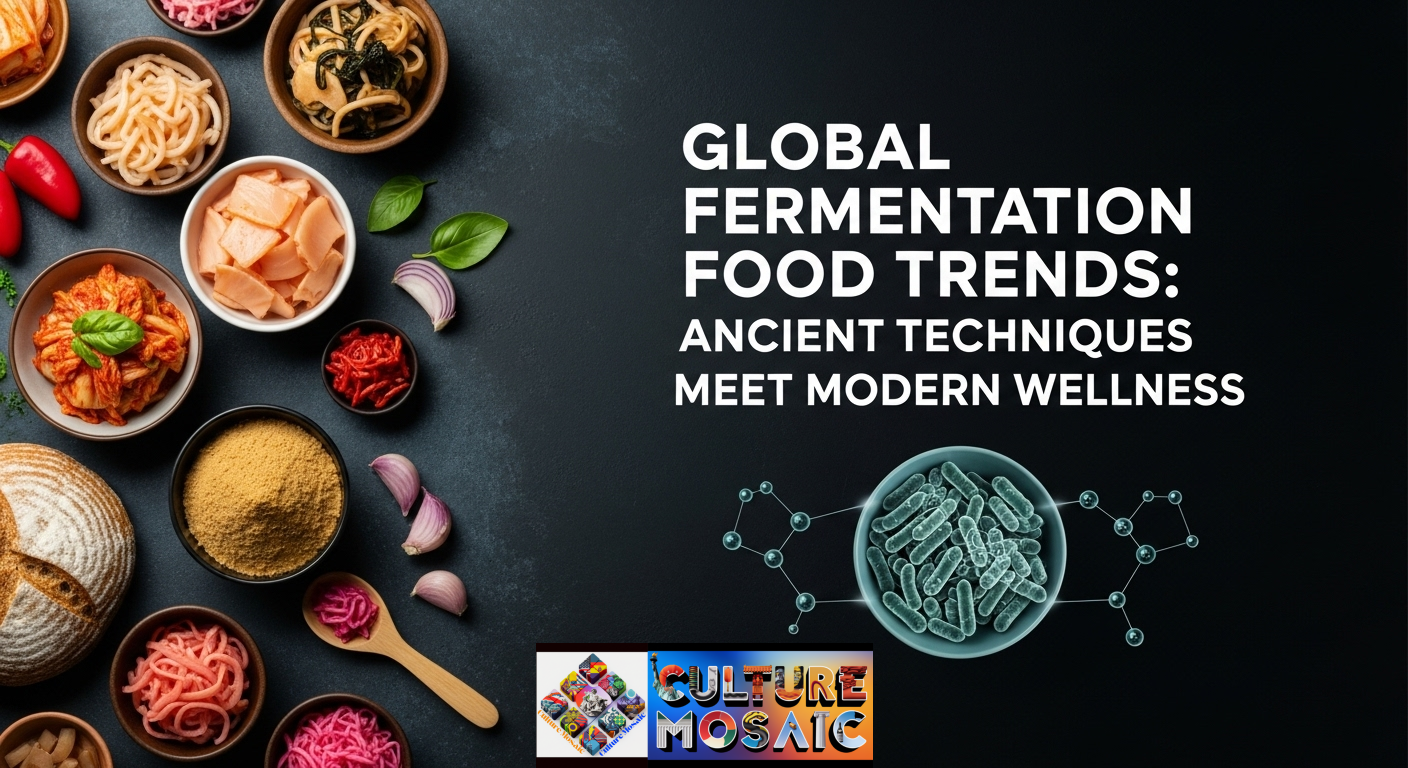Global Fermentation Food Trends: Fermentation isn’t new. People have been preserving food this way for thousands of years, turning cabbage into sauerkraut in Germany, soybeans into miso in Japan, and milk into yogurt across the Middle East. But something interesting is happening right now. These ancient techniques are having a massive moment in modern kitchens, and it’s not just about nostalgia.
Walk into any grocery store in America today, and you’ll find kombucha taking up half the beverage aisle. Kimchi sits next to the regular coleslaw. Sourdough bread, once a niche bakery item, is now something people are making at home and posting about on TikTok. The global fermentation food trends we’re seeing aren’t just a passing fad. They’re a fundamental shift in how we think about food, health, and flavor.
Why Global Fermentation Food Trends Matter Now
The timing makes sense when you look at what people actually care about. Gut health has moved from fringe wellness circles into mainstream conversation. We’re learning that the bacteria in our digestive system affect everything from mood to immunity, and fermented foods are one of the most natural ways to support that ecosystem.
But health is only part of the story. These foods taste incredible. The tangy complexity of a well-fermented pickle, the umami depth of aged miso, the slight funk of natto—these aren’t flavors you can replicate with fresh ingredients alone. Time and microbes create something entirely different.
There’s also a cultural curiosity at play. Younger generations, particularly Gen Z and Millennials, aren’t satisfied with bland, mass-produced food. They want to know where their food comes from, how it’s made, and what traditions it represents. Fermentation checks all those boxes. It’s authentic, it has a story, and it connects us to culinary practices that have sustained communities for centuries.
The Science Behind Global Fermentation Food Trends
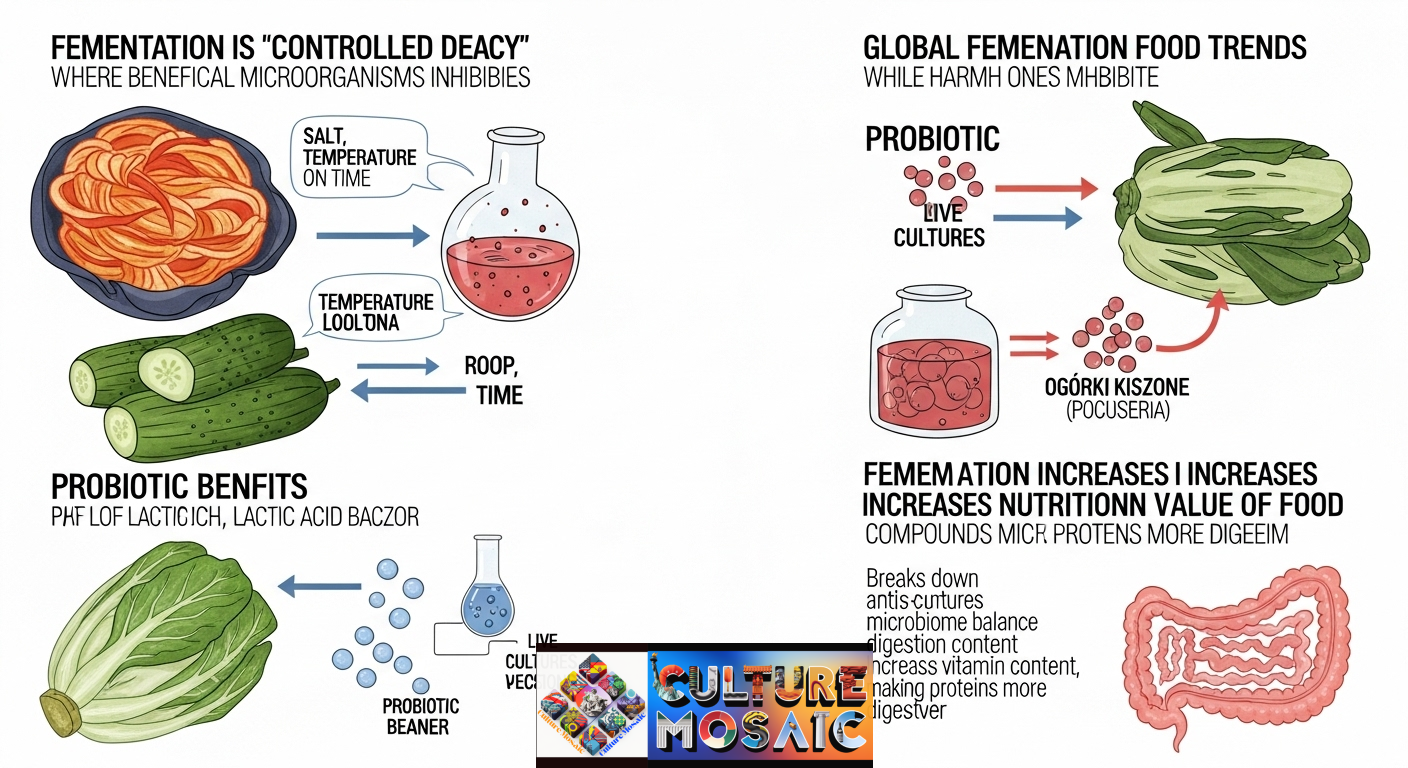
Fermentation is essentially controlled decay. You create an environment where beneficial bacteria, yeasts, or molds can thrive while harmful microorganisms can’t. Salt, temperature, and time are your main tools.
When you ferment vegetables, for example, naturally occurring lactic acid bacteria convert sugars into lactic acid. This acid lowers the pH, preserving the food and creating that characteristic tangy flavor. The same principle applies whether you’re making Korean kimchi or Polish ogórki kiszone.
The probiotic benefits come from these live cultures. When you eat fermented foods that haven’t been pasteurized, you’re consuming millions of beneficial bacteria. These microorganisms can help balance your gut microbiome, aid digestion, and potentially support immune function. Research continues to uncover connections between gut health and everything from mental health to chronic disease prevention.
What makes fermentation special is that it actually increases the nutritional value of food. The fermentation process can break down compounds that interfere with nutrient absorption, increase vitamin content, and make proteins more digestible. A bowl of kimchi isn’t just preserved cabbage. It’s a fundamentally more nutritious version of the raw ingredient.
Korean Fermentation: Kimchi and Beyond
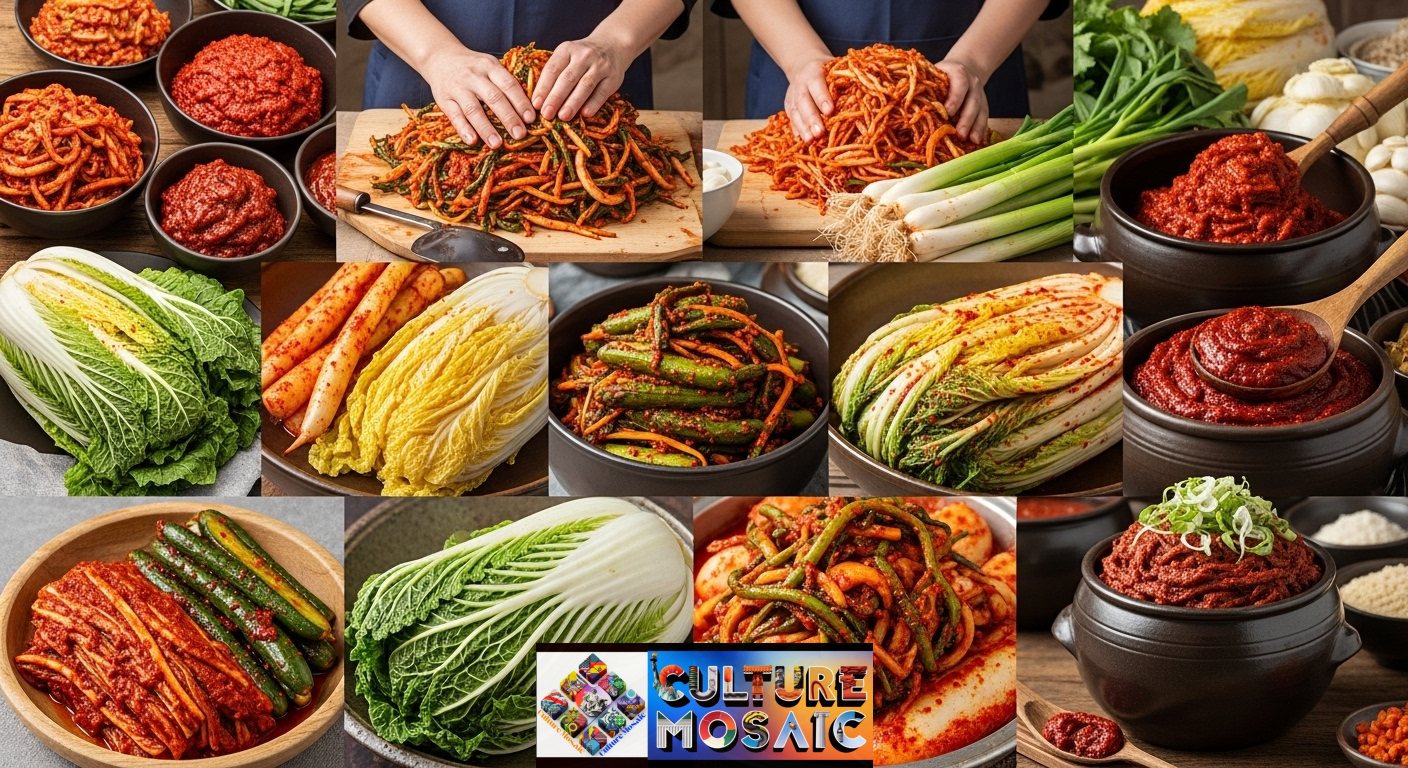
Korea has elevated fermentation to an art form. Kimchi, the country’s most famous export, comes in hundreds of varieties. The basic version uses napa cabbage, but you’ll find kimchi made from radish, cucumber, scallions, and even oysters or shrimp.
Traditional kimchi-making, called kimjang, is a communal event. Families gather in late fall to prepare enough kimchi to last through winter. The vegetables are salted, rinsed, then coated in a paste made from gochugaru (Korean red pepper flakes), garlic, ginger, fish sauce, and other aromatics. The mixture ferments for days or weeks, developing complex flavors that balance spicy, sour, salty, and umami.
But Korean fermentation doesn’t stop at kimchi. Gochujang, the thick red pepper paste, ferments for months or even years. Doenjang, similar to Japanese miso, brings deep savory notes to stews and marinades. These condiments represent global fermentation food trends that have moved far beyond Korean restaurants into mainstream American cooking.
The explosion of Korean pop culture has helped drive this interest. As K-dramas and K-pop gained global audiences, people became curious about Korean food. Home cooks started experimenting with kimchi in tacos, burgers, and grain bowls. What began as cultural exploration became a staple ingredient.
Japanese Fermentation: Miso, Natto, and Tsukemono
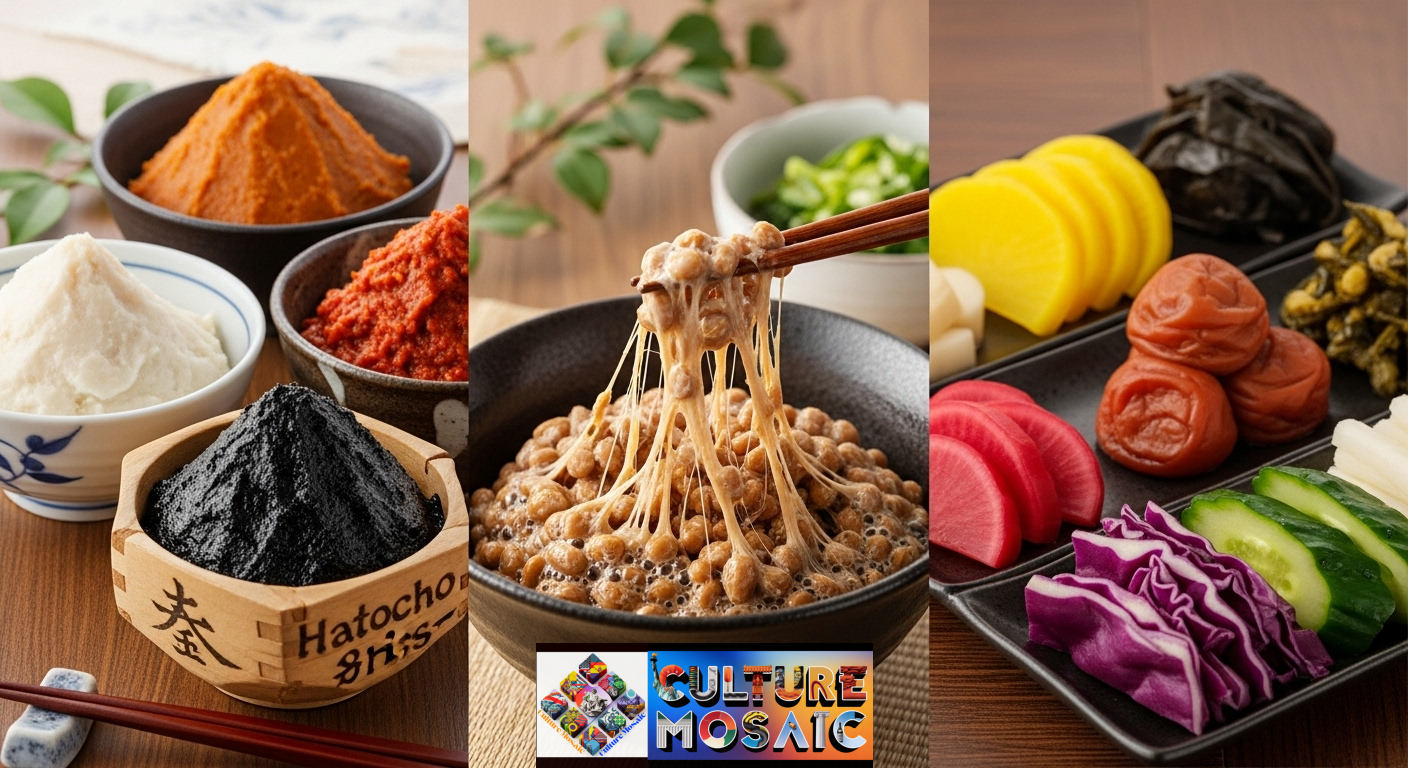
Global Fermentation Food Trends: Japanese fermentation traditions run deep. Miso alone has been made for over a thousand years. The process involves fermenting soybeans with koji, a mold cultivated on rice or barley. The result can range from sweet and mild white miso, fermented for a few weeks, to rich and intense red miso, aged for years.
Every region in Japan has its own miso style. Sendai is known for red miso, Kyoto for sweet white miso, and Nagoya for dark, almost chocolate-colored Hatcho miso. This regional diversity reflects how deeply fermentation is woven into local identity and cuisine.
Natto presents a different side of Japanese fermentation. These sticky, pungent fermented soybeans have a devoted following in Japan and an acquired-taste reputation elsewhere. The sliminess comes from the bacterial fermentation, which creates long, stringy polymers. Nutritionally, natto is a powerhouse, loaded with vitamin K2, which is rare in most diets.
Tsukemono, or Japanese pickles, encompass a huge range of preserved vegetables. From the bright yellow takuan (daikon radish) to umeboshi (salt-pickled plums), these accompaniments add contrast and cleansing elements to Japanese meals. The variety demonstrates how fermentation can transform simple ingredients into distinctive flavors that define a cuisine.
European Fermentation Heritage: Sourdough and Sauerkraut
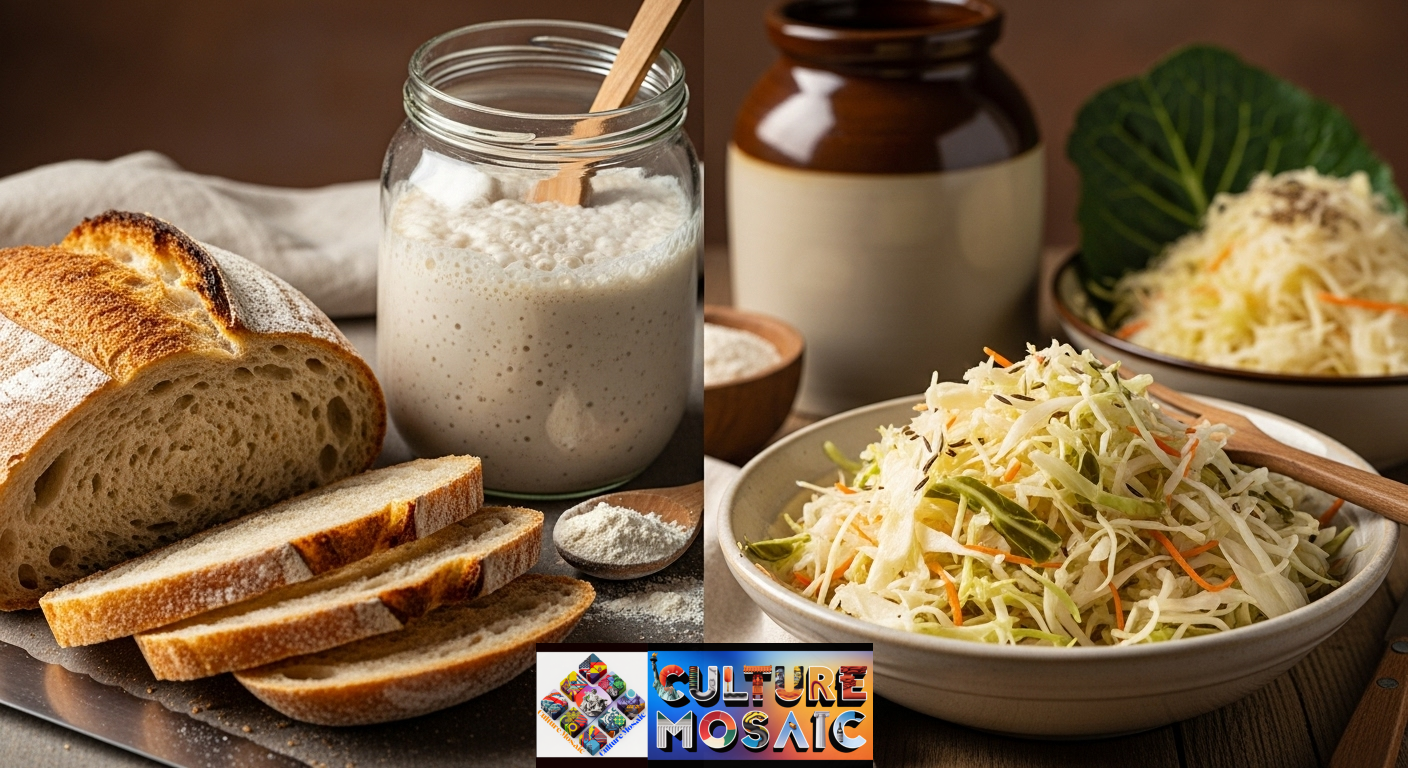
Global Fermentation Food Trends: Europe’s fermentation traditions are equally rich, though sometimes less exotic-seeming to American audiences. Sourdough bread, made with wild yeast cultures instead of commercial yeast, has been a staple across Europe for millennia. Each starter culture is unique, capturing the specific yeasts and bacteria in a particular environment.
The sourdough revival during pandemic lockdowns wasn’t random. People craved connection to traditional food practices and had time to nurture a living culture. Feeding a sourdough starter, watching it bubble and grow, then baking bread with your hands—this process resonates on a deeper level than buying a loaf at the store.
Sauerkraut represents Central and Eastern European preservation techniques. The German method is straightforward: shred cabbage, mix with salt, pack tightly, and let it ferment. The simplicity is deceptive. Temperature, salt percentage, and fermentation time all affect the final flavor. When done right, sauerkraut has a crisp texture and bright acidity that complements rich foods.
Eastern European countries have their own variations. Polish kapusta kiszona, Russian кислая капуста, and Czech kysané zelí all follow similar principles but reflect local preferences. These aren’t just side dishes. They’re essential elements of traditional cuisine, providing vital nutrients during harsh winters when fresh vegetables weren’t available.
Global Fermentation Food Trends in Beverages
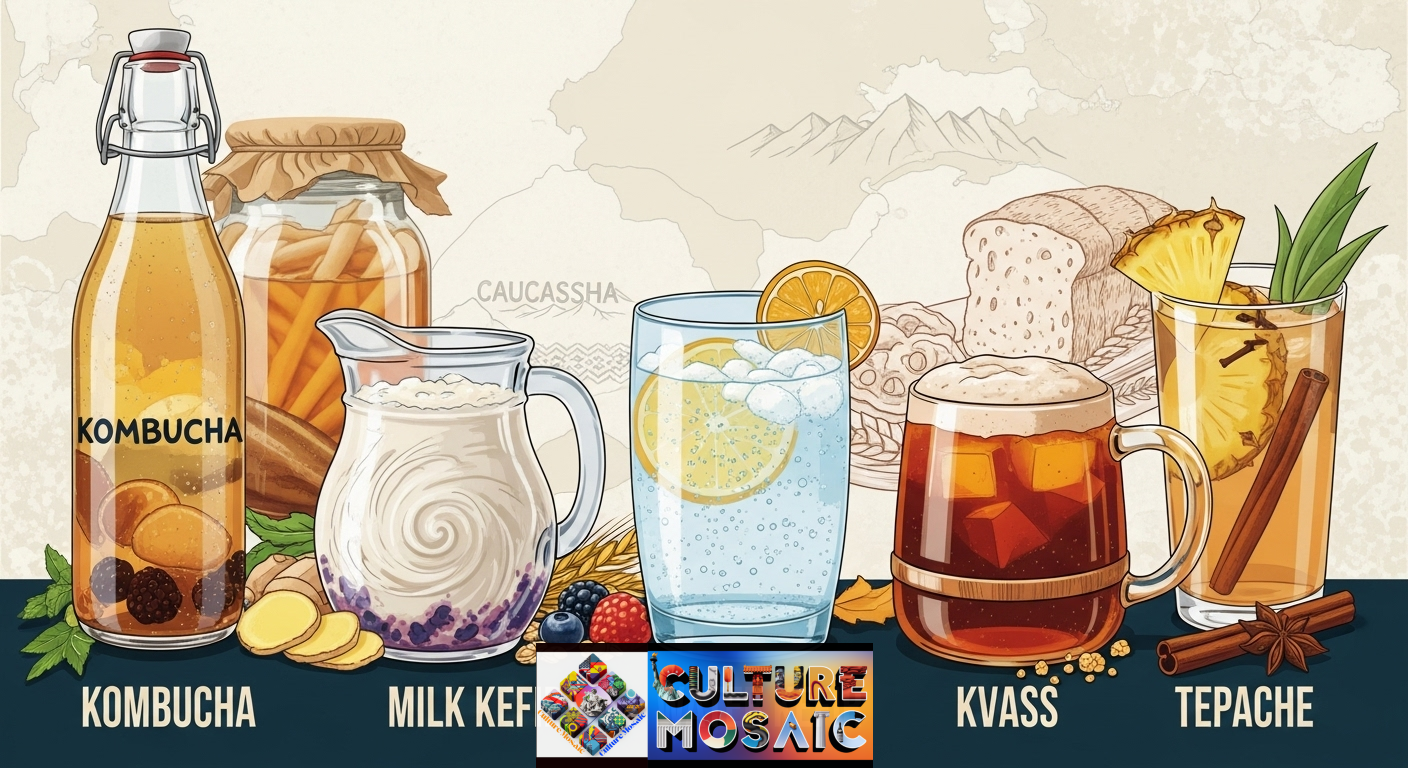
Kombucha has become the gateway fermented beverage for many Americans. This fizzy, slightly sweet, slightly tart drink is made by fermenting sweetened tea with a SCOBY—a symbiotic culture of bacteria and yeast. The gelatinous SCOBY looks strange, but produces a drink that’s more accessible than many fermented foods.
The kombucha market exploded over the past decade. What started in health food stores now occupies significant shelf space in conventional supermarkets. Brands experiment with flavors from ginger-lemon to lavender-elderflower, making kombucha appealing to a broad audience.
But global fermentation food trends in beverages extend far beyond kombucha. Kefir, a fermented milk drink from the Caucasus region, has gained traction as a drinkable probiotic. Water kefir offers a non-dairy alternative. Kvass, a traditional Slavic beverage made from fermented rye bread, is starting to appear in specialty shops.
Tepache, a Mexican fermented pineapple drink, represents another tradition entering the mainstream. Made by fermenting pineapple rinds with brown sugar and spices, tepache is lightly alcoholic, refreshing, and sustainable since it uses parts of the fruit typically discarded.
These beverages share common threads: they’re probiotic-rich, relatively low in sugar compared to soft drinks, and connected to specific cultural traditions. As people seek alternatives to processed beverages, fermented drinks offer both health benefits and authentic flavors.
African Fermentation Traditions
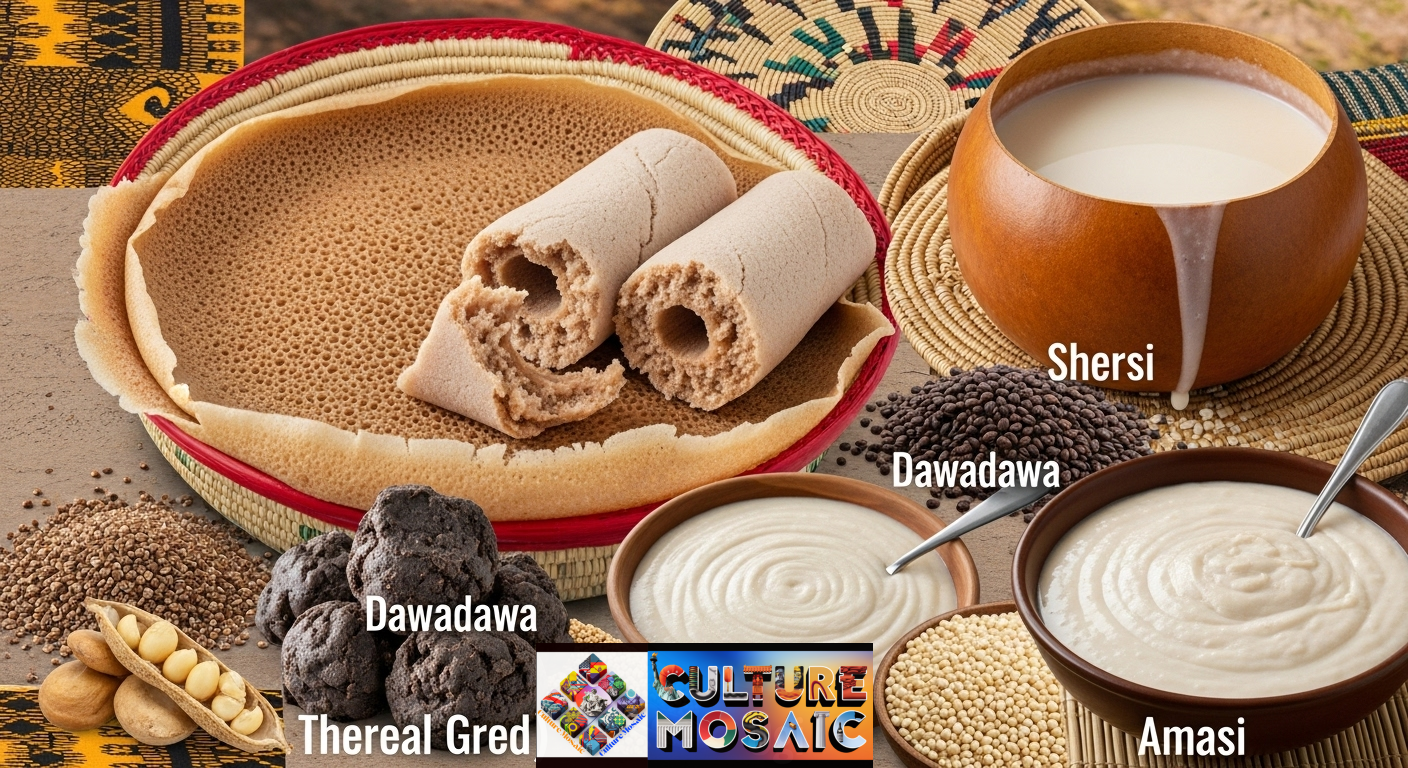
Global Fermentation Food Trends: African fermentation traditions remain underexplored in Western markets, but that’s slowly changing. Injera, the spongy Ethiopian flatbread, is made from teff flour fermented for several days. The fermentation creates the distinctive sour flavor and airy texture that makes injera perfect for soaking up stews and sauces.
West African cuisine relies heavily on fermented ingredients. Dawadawa, made from fermented locust beans, adds umami depth to soups and stews across Nigeria, Ghana, and neighboring countries. Ogi, a fermented cereal pudding, serves as a breakfast staple and weaning food for babies.
South African fermentation includes amasi, a fermented milk similar to buttermilk, traditionally prepared in calabash gourds. The natural bacteria in the gourd and the surrounding environment facilitate fermentation. This traditional food is now being studied for its potential probiotic benefits and cultural preservation.
These African fermented foods represent global trends in fermented foods that deserve wider recognition. They’re nutritionally valuable, deeply flavorful, and connected to sophisticated food preservation techniques developed over centuries. As interest in African cuisine grows, these fermented elements will likely become more prominent.
South American Fermentation Practices: Global Fermentation Food Trends
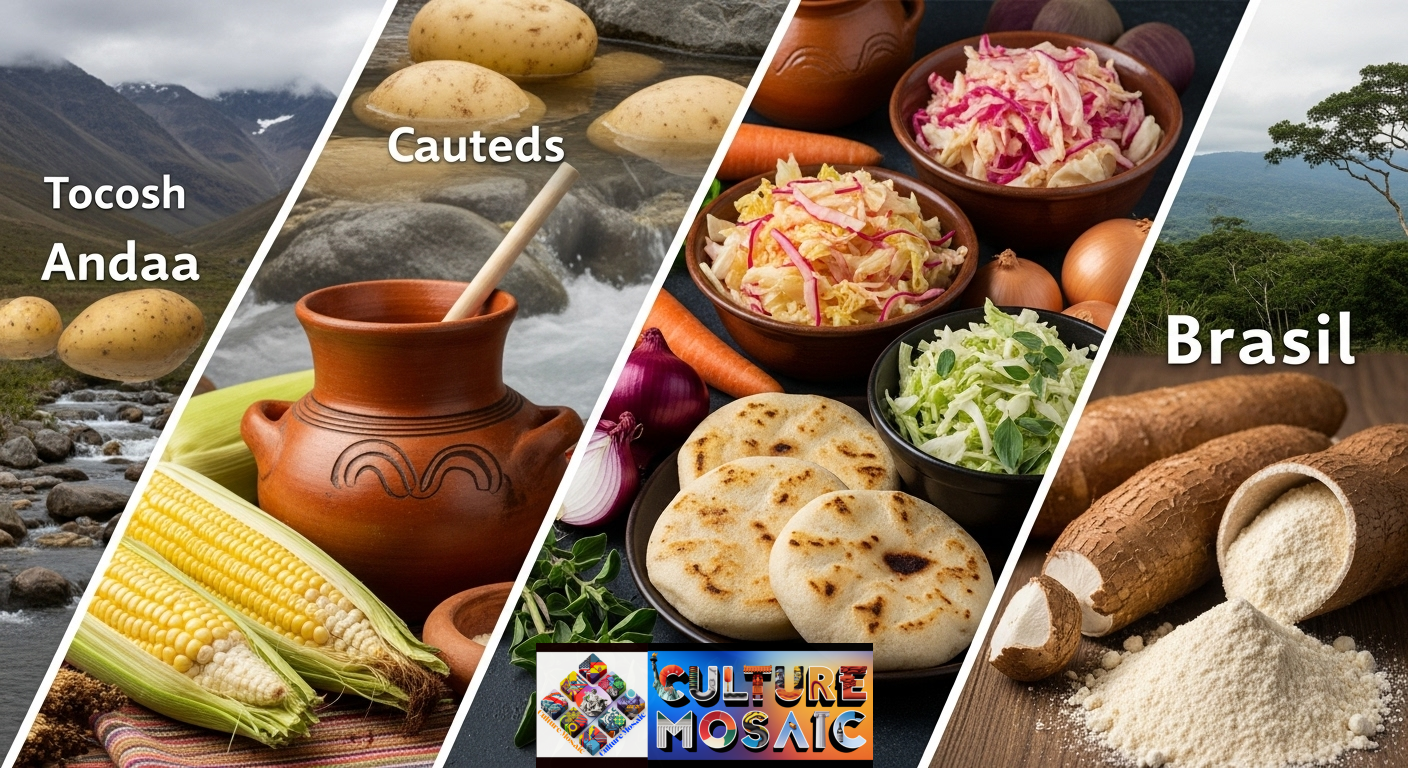
South American fermentation traditions blend indigenous techniques with influences from European colonization and African diaspora. Chicha, a fermented corn beverage, has been made in the Andes for thousands of years. Traditional preparation involved chewing corn to break down starches with salivary enzymes before fermentation, though modern methods use malted corn.
Tocosh, from Peru, involves fermenting potatoes in cold mountain streams for months. The resulting product is dried and used as a medicinal food, believed to aid digestion and have antibiotic properties. This extreme fermentation creates intense flavors and preserves potatoes for long-term storage in challenging environments.
Curtido, the Salvadoran fermented cabbage slaw, appears alongside pupusas throughout Central America. Similar to sauerkraut but seasoned with oregano and often including carrots and onions, curtido shows how fermentation techniques adapt to local ingredients and preferences.
Brazilian cuisine features farofa made with cassava flour, sometimes fermented to reduce cyanide compounds and improve digestibility. These practical applications of fermentation technology—making foods safer and more nutritious—remind us that these weren’t just culinary choices. They were survival strategies.
Home Fermentation: Getting Started
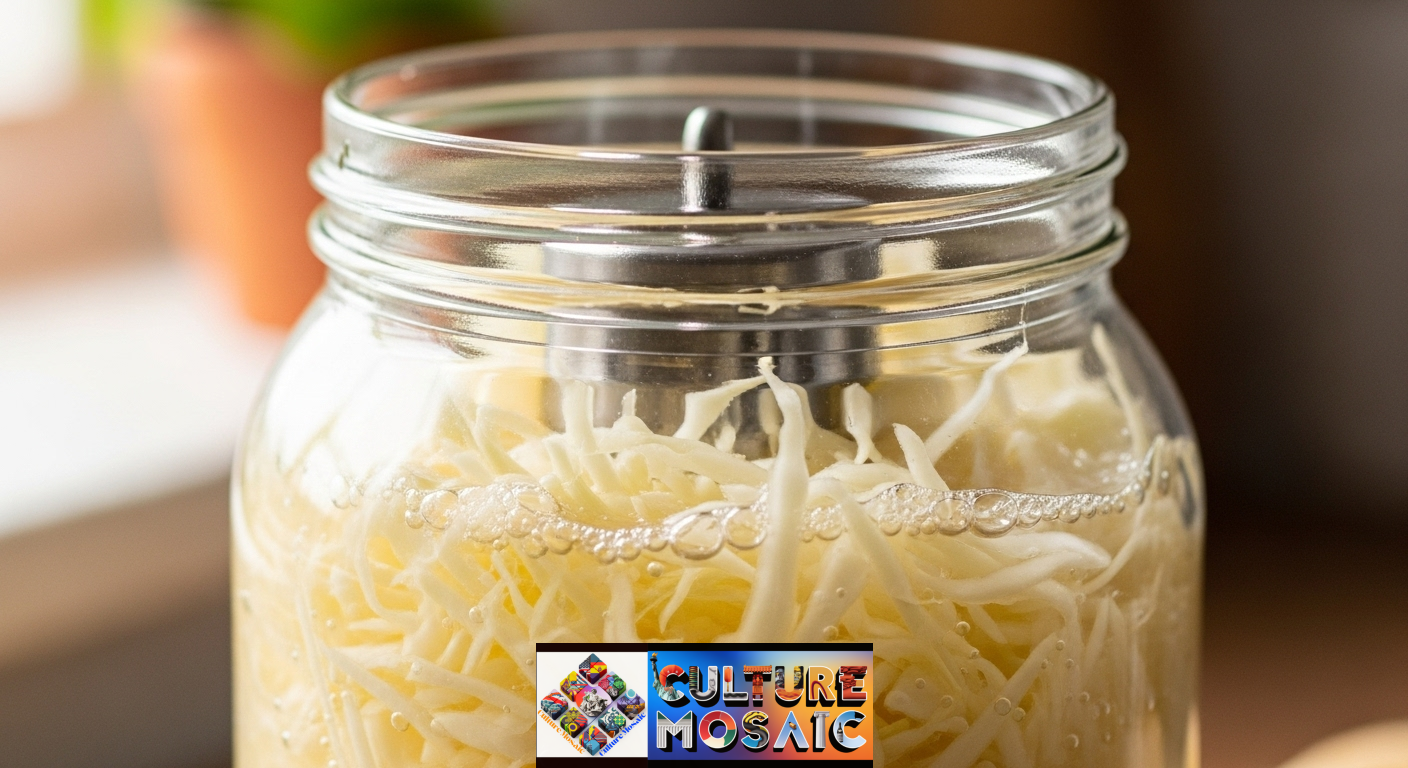
The global fermentation food trends have inspired countless people to try fermenting at home. The good news is that basic fermentation is remarkably forgiving. You don’t need special equipment or expertise to get started.
Sauerkraut is the perfect beginner project. All you need is cabbage, salt, and a jar. Shred the cabbage, massage it with salt until it releases liquid, pack it tightly into a jar, and make sure the cabbage stays submerged in the brine. Within a few days, you’ll see bubbles forming as lactic acid bacteria get to work.
The key principle for vegetable fermentation is creating an anaerobic environment with enough salt to prevent harmful bacteria while allowing beneficial bacteria to thrive. A salt concentration of about two to three percent by weight works for most vegetables. Keep the vegetables submerged, either with a weight or by pressing them down regularly, and let time do its work.
Temperature affects fermentation speed. Warmer temperatures (around seventy to seventy-five degrees Fahrenheit) speed things up, while cooler temperatures slow the process. You can taste as you go. Fermentation is finished when the flavor appeals to you. Some people prefer a mild ferment after three to five days, while others let vegetables ferment for weeks to develop more complexity.
Mistakes are rare if you follow basic guidelines. If something smells rotten rather than pleasantly sour, or if you see mold growing (not just a white film on top, which is harmless kahm yeast), discard the batch and start over. Trust your senses. Fermented foods should smell appealing, not off-putting.
Restaurant and Industry Adoption: Global Fermentation Food Trends
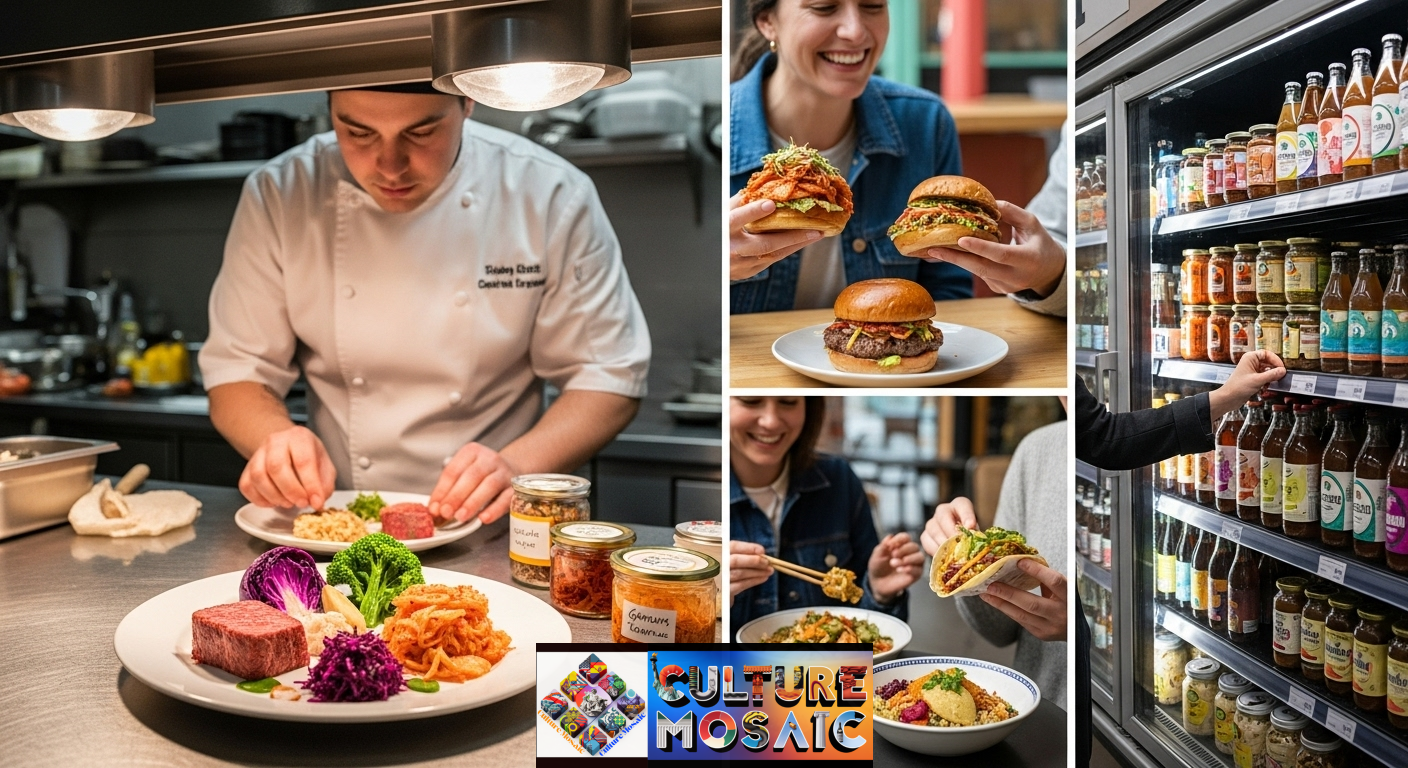
Professional kitchens have embraced global fermentation food trends with enthusiasm. High-end restaurants use fermentation to create unique flavors that set them apart. Chefs ferment vegetables for unexpected sides, age proteins in koji for tenderness and umami, and experiment with garum—a fermented fish sauce—using local ingredients.
Noma in Copenhagen, widely considered one of the world’s best restaurants, operates a dedicated fermentation lab. Chef René Redzepi’s team ferments everything from grasshoppers to bee pollen, pushing boundaries while honoring traditional techniques. This high-profile experimentation has influenced chefs globally.
Fast-casual restaurants have also caught on. Kimchi appears on burgers and tacos. Miso gets whisked into salad dressings and glazes. Pickled vegetables add acidity and crunch to grain bowls. What was once exotic is now expected.
The food industry has responded to consumer demand for fermented products. Store-bought kimchi and sauerkraut are widely available, though quality varies. Reading labels matters—look for products in the refrigerated section that list live cultures and haven’t been pasteurized. Shelf-stable versions have been heat-treated, killing the beneficial bacteria.
Innovative companies are creating new fermented products that blend tradition with modern convenience. Fermented hot sauces, miso-based spreads, and probiotic elixirs cater to health-conscious consumers who want the benefits of fermentation without the time investment of making their own.
Health Benefits Driving Global Fermentation Food Trends
Global Fermentation Food Trends: The gut microbiome has become a hot topic in nutrition science. Researchers are discovering that the trillions of microorganisms in our digestive system affect far more than digestion. The gut microbiome influences immune function, mental health, metabolism, and even chronic disease risk.
Fermented foods introduce beneficial bacteria into this complex ecosystem. While probiotic supplements offer concentrated doses of specific strains, fermented foods provide diverse bacterial communities along with the food matrix that supports their survival through digestion.
Regular consumption of fermented foods has been linked to improved digestion, reduced inflammation, and better immune response. Some studies suggest fermented foods may help with conditions like irritable bowel syndrome, though individual responses vary.
Beyond probiotics, fermentation creates other beneficial compounds. The fermentation process can produce vitamins, particularly B vitamins and vitamin K2. It can reduce anti-nutrients like phytic acid, making minerals more bioavailable. And it can partially break down proteins and carbohydrates, making them easier to digest.
The mental health connection is particularly intriguing. The gut-brain axis—the communication network between the digestive system and the brain—appears to be influenced by gut bacteria. Some research suggests that fermented foods may help with anxiety and depression, though this field is still emerging and more studies are needed.
Environmental and Sustainability Aspects: Global Fermentation Food Trends
Fermentation aligns with current sustainability concerns in several ways. It’s a low-energy preservation method that doesn’t require refrigeration during the fermentation process. Traditional fermentation relied entirely on ambient temperature and natural bacteria, creating a genuinely zero-waste preservation technique.
Using fermentation to preserve seasonal abundance reduces food waste. When you have more cucumbers than you can eat fresh, fermenting them extends their life for months. This practice of preserving summer’s bounty to eat through winter represents a fundamentally sustainable approach to food.
Fermentation can also make use of ingredients that might otherwise be discarded. Tepache made from pineapple rinds, vinegar made from apple scraps, and garum made from fish parts all transform waste into valuable ingredients. This resourcefulness resonates with modern efforts to reduce food waste.
Some fermented products, particularly those using koji, can help reduce reliance on meat. Koji-aged vegetables develop such deep umami flavors that they can satisfy the craving for savory, rich tastes without animal products. This application of traditional techniques to contemporary dietary concerns shows how global fermentation food trends adapt to current needs.
Cultural Preservation and Appropriation: Global Fermentation Food Trends
As global fermentation food trends grow, questions of cultural preservation and appropriation arise. When a traditional food becomes trendy in markets far from its origin, who benefits? How do we honor the cultures that developed these techniques while making them accessible to new audiences?
The best approach involves giving credit and context. When you write about kimchi, acknowledge its Korean origins and cultural significance. When you sell miso, explain the centuries of Japanese fermentation knowledge that created it. This isn’t just respectful—it enriches the experience for everyone.
Supporting businesses owned by people from the cultures that created these foods helps ensure that the economic benefits don’t just flow to those who discovered them last. Buying kimchi made by Korean Americans, miso from Japanese producers, or sauerkraut from German-American companies maintains cultural connections.
Learning the proper techniques and respecting traditional methods matters too. While innovation is valuable, understanding the why behind traditional practices prevents mistakes and maintains the integrity of the food. There’s a difference between creative adaptation and careless copying.
At the same time, fermentation is a human universal. Every culture developed some form of fermentation independently. Sharing techniques and learning from each other has always been part of food culture. The key is approaching these exchanges with respect, curiosity, and acknowledgment of origins.
Future of Global Fermentation Food Trends
The momentum behind global fermentation food trends shows no signs of slowing. If anything, it’s accelerating. Several factors suggest fermentation will become even more mainstream in coming years.
Climate change makes food preservation more relevant. As weather patterns become less predictable, the ability to preserve food without refrigeration gains practical importance. Fermentation offers a resilient preservation method that doesn’t depend on complex supply chains.
Scientific research continues to reveal health benefits, driving more consumer interest. As we learn more about the microbiome and its wide-ranging effects on health, fermented foods will likely be recommended more frequently by healthcare providers.
Technology is making fermentation more accessible. Smart fermentation vessels with temperature control, pH monitoring, and app connectivity remove some of the guesswork for beginners. While traditional fermentation doesn’t need technology, these tools can help people gain confidence.
Regional and unusual fermentations will likely gain attention as consumers seek new experiences. Ethiopian injera, West African dawadawa, and Peruvian tocosh represent just a few traditions that could become the next kimchi or kombucha in Western markets.
The DIY movement supports continued growth in home fermentation. People want to understand their food, reduce reliance on industrial systems, and develop new skills. Fermentation checks all these boxes while producing something delicious and nutritious.
Practical Tips for Exploring Global Fermentation Food Trends
Global Fermentation Food Trends: If you’re new to fermented foods, start with small amounts. Your gut microbiome may need time to adjust, especially if you haven’t regularly consumed fermented foods. A few forkfuls of sauerkraut or a small glass of kombucha is enough to begin.
Quality matters significantly. Live-culture, unpasteurized products provide the probiotic benefits. Check labels carefully. Words like “raw” and “contains live cultures” indicate what you’re looking for. Shelf-stable products have been heat-treated and won’t provide the same benefits, though they may still taste good.
Variety helps because different fermented foods contain different bacterial strains. Rotating between kimchi, kefir, miso, and sauerkraut exposes your gut to a wider range of beneficial microorganisms than sticking to just one product.
Incorporate fermented foods into meals you already enjoy rather than treating them as separate health supplements. Add kimchi to fried rice. Stir miso into soup. Top your salad with fermented vegetables. This integration makes fermentation a natural part of your diet rather than a chore.
If you want to try fermenting at home, start simple. Sauerkraut or quick pickles require minimal investment and have a high success rate. As you gain confidence, you can explore more complex projects like miso or kombucha that require specialized ingredients or longer fermentation times.
Connect with communities of fermenters, either online or in person. People who ferment are generally enthusiastic about sharing their knowledge. Forums, social media groups, and local workshops provide support and inspiration as you explore global fermentation food trends.
Conclusion: Global Fermentation Food Trends
Global fermentation food trends represent more than a passing dietary fad. They connect us to food preservation techniques that sustained humanity for millennia. They offer genuine health benefits through probiotic content and improved nutrition. They deliver complex, satisfying flavors that modern industrial food production can’t replicate.
The revival of fermentation speaks to deeper desires: for authentic food with real stories, for control over what we eat, for connection to traditions and cultures beyond our own. In a world of processed convenience foods, fermentation offers something genuinely different.
Whether you’re spooning kimchi onto your breakfast eggs, stirring miso into salad dressing, or nurturing your own sourdough starter, you’re participating in food traditions that span continents and centuries. These aren’t museum pieces. They’re living practices that continue to evolve while remaining rooted in time-tested wisdom.
The future of food will likely include more fermentation, not less. As we seek sustainable preservation methods, ways to support gut health, and authentic flavors, fermented foods check every box. The ancient future of food is already here, bubbling away in jars on kitchen counters around the world.
Frequently Asked Questions About Global Fermentation Food Trends
What are the main health benefits of fermented foods?
Fermented foods provide live beneficial bacteria (probiotics) that support gut health and digestion. The fermentation process also increases nutrient bioavailability, creates additional vitamins, and may help reduce inflammation. Regular consumption of diverse fermented foods can support immune function and may positively affect mental health through the gut-brain connection.
Is it safe to ferment foods at home?
Yes, home fermentation is safe when you follow basic guidelines. The combination of salt and acidity creates an environment where harmful bacteria cannot survive while beneficial bacteria thrive. Trust your senses—fermented foods should smell pleasantly sour, not rotten. If you see fuzzy mold or the smell is off-putting, discard the batch. Start with simple projects like sauerkraut to build confidence.
How long do fermented foods last?
Properly fermented foods last for months when stored in the refrigerator. The acidic environment naturally preserves them. Sauerkraut and kimchi can last six months or longer. Miso can last over a year. Once fermentation reaches your desired flavor, refrigeration slows but doesn’t stop the process. The foods become more sour over time but remain safe to eat as long as they smell and taste good.
Do all fermented foods contain probiotics?
Only unpasteurized, live-culture fermented foods contain active probiotics. Many store-bought fermented products are pasteurized for shelf stability, which kills the beneficial bacteria. Look for refrigerated products labeled as containing live cultures or marked as raw. Alcoholic fermented beverages like beer and wine don’t provide probiotic benefits because the yeasts are typically filtered out or dead.
What’s the easiest fermented food to make at home?
Sauerkraut is the simplest starting point for home fermentation. You need only two ingredients: cabbage and salt. Shred the cabbage, massage it with salt until liquid releases, pack it into a jar, keep it submerged, and wait a few days. Quick pickles with vegetables like cucumbers, carrots, or radishes are also beginner-friendly and require minimal time investment while teaching basic fermentation principles.

